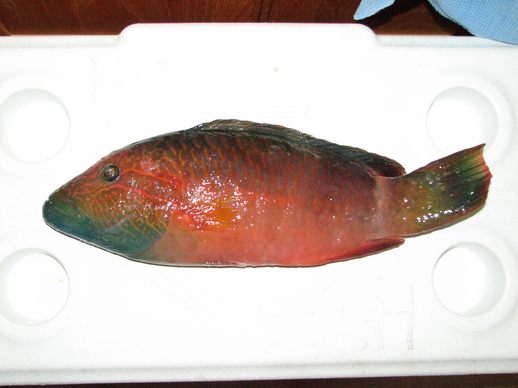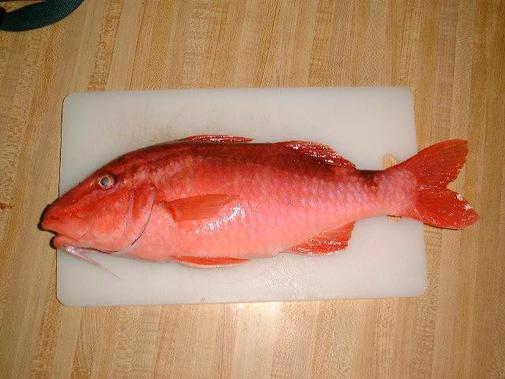Bottom Fishing Out of Hilo…
Most of the bottom fishing I do falls into three categories: bottom bouncing down steep slopes in water less than 200′ deep, slow drifting in waters 125-250′ deep and snapper fishing in water depths of 300′ and deeper. Most of this page will be spent talking about the first two categories.
At different times in the past, seawater levels have been considerably lower than they are now. From Hilo going East to Kumukahi lighthouse there is a ledge that’s 40-60′ deep with drop offs that bottom out at 180-225′ in the course of a few hundred feet of lateral drift. There are also drowned reefs with tops at ~ 80-100′ that also drop 50-100′ feet to mud/sand/rubble bottoms. These reefs are common in front of the Hilo breakwall and are several square miles in total extent.
In the normal course of events because of advective heating and cooling, a breeze coming from the mountains toward the oceans begins several hours after sunset and continues through the night until several hours after sunrise. Then the mountains begin to heat up and the winds first cease and then reverse directions, now moving toward the mountains. This offshore wind can also last several hours longer if there is pervasive rain in the mountains. Given that it’s generally better to bounce leads and baited hooks down hill than up, I favor the early morning hours with an offshore breeze for bottom bouncing fishing. When the mountain breeze stops and then reverses I switch to either jigging or deeper water slow drifting.
For steep slope bottom bouncing my rig is very simple. I begin with ~ 10-12′ length of 20# test monofilament. I then tie a bottom end loop followed by three dropper loops at 1′ intervals and finally end up with a small swivel at the top end to which the main line snap swivel attaches. Each dropper loop is ~ 4-5″ long. The end is then pinched and fit through the eye of a #6 Mustad 7766 tarpon hook, coming from the hook point direction. The loop coming through the eye then goes over the whole hook and is finally pulled tight against the eye. An overhand knot is tied halfway down the length of each dropper loop to increase stiffness and reduce tangling. I mash the barbs of all my bottom fishing and jigging hooks. This makes it much easier to remove unwanted catch (read: triggerfish and/or self). I use either squid cut into 2″ long narrow wedges or 2″ size “scroungers” (also called “curly tails”) in firecracker (red and blue in a clear matrix) and silver (silver glitter in a clear matrix) colors. Depending on the drift rate I use either a 4 or 5 oz. bank sinker that’s attached to the bottom loop with a light rubber band. My main line is usually braid of some sort, PowerPro or whatever and about 20-30# test.
For slow drifting the rig is nearly the same. Slow drift fishing seems to target more fish with teeth such as a’awa (aka Table Boss) and po’ou. In this case I take a 6-8″ length of 12-15# sevalon (plastic coated copper or brass twisted wire), make a loop of it and double loop this wire loop into each dropper loop. Once again, the end of the wire loop is pinched and attached to a #6 Mustad 7766 tarpon hook and finally an overhand knot tied in the middle of this loop as well. Cut bait from small ta’ape works very well for this type of fishing. Cut bait from small moano is good but the skin is not as tough as that of the ta’ape. I’ve made a simple plastic bait cutting board that fits on top of the motor battery box. The board includes a clamp for fastening the bait tail to the board during scaling, a modified spoon for scaling and an inexpensive filet knife for bait cutting.
For both styles of fishing I use a light drag and “easy-by-slow” style of retrieval making sure that tension is continually applied to the line – especially since the hooks are barbless.
Bottom fishing is great because of the simplicity of style and the variety of fish caught and kept: moano (many bar goatfish, Parupeneus multifasciatus), munu (island goatfish, Parupeneus insularis), moano hulu/kali (Parupeneus cyclostomus), ?), kumu (white saddle goatfish, Parupeneus porphyreus), ta’ape (blue-striped snapper, Lutjanus kasmira) , to’au (Black tail snapper, Lutjanus fulvus), uku (green jobfish, Aprion viriscens) , omilu (blue fin trevally, Caranx melanpygus), yellow spot (island jack, Carangoides orthogrammus), ‘a’awa (table boss, Hawaiian hogfish, (Bodianus albotaeniatus), , Oxycheilinus unifasciatus), kawelea/kamasu (Heller’s barracuda, Sphyraena helleri) and nabeta/laenihi (peacock razorfish, (Iniistius pavo). More regarding descriptions, habits and distribution for the above may be found at www.fishbase.org. See also “Reef and Shore Fishes of the Hawaiian Islands”, John E. Randall, Sea Grant College Program, University of Hawai’i, Honolulu, 2007.
 po’ou (Ring tail wrasse po’ou (Ring tail wrasse |
 weke ula (Mulloidichthys varicolensis weke ula (Mulloidichthys varicolensis |